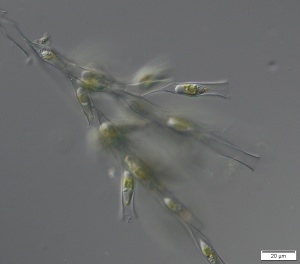Difference between revisions of "Algae around UConn"
From EEBedia
m |
m (→Biodiversity hidden to the naked eye) |
||
| Line 1: | Line 1: | ||
==Biodiversity hidden to the naked eye== | ==Biodiversity hidden to the naked eye== | ||
| − | + | Microorganisms are incredibly diverse. A small sample of water from a local pond can contain dozens of species - some related to plants, some related to fungi, and some belonging to completely different, ancient lineages of eukaryotes. Algae are a subset of this diversity: they are organisms that contain a photosynthetic organelle (plastid). Here are a few examples of the charismatic algae found in the vicinity of the University of Connecticut | |
| − | + | *Dinobryon is a colonial flagellated alga from the class Chrysophyceae, a member of the [http://tolweb.org/Stramenopiles/2380 Stramenopiles]. | |
| − | [[Image:Dinobryon.jpg|thumb|left|''Dinobryon | + | [[Image:Dinobryon.jpg|thumb|left|''Dinobryon sertularia'' from Walker Reservoir, Vernon, CT]] |
Revision as of 18:02, 19 June 2014
Microorganisms are incredibly diverse. A small sample of water from a local pond can contain dozens of species - some related to plants, some related to fungi, and some belonging to completely different, ancient lineages of eukaryotes. Algae are a subset of this diversity: they are organisms that contain a photosynthetic organelle (plastid). Here are a few examples of the charismatic algae found in the vicinity of the University of Connecticut
- Dinobryon is a colonial flagellated alga from the class Chrysophyceae, a member of the Stramenopiles.
